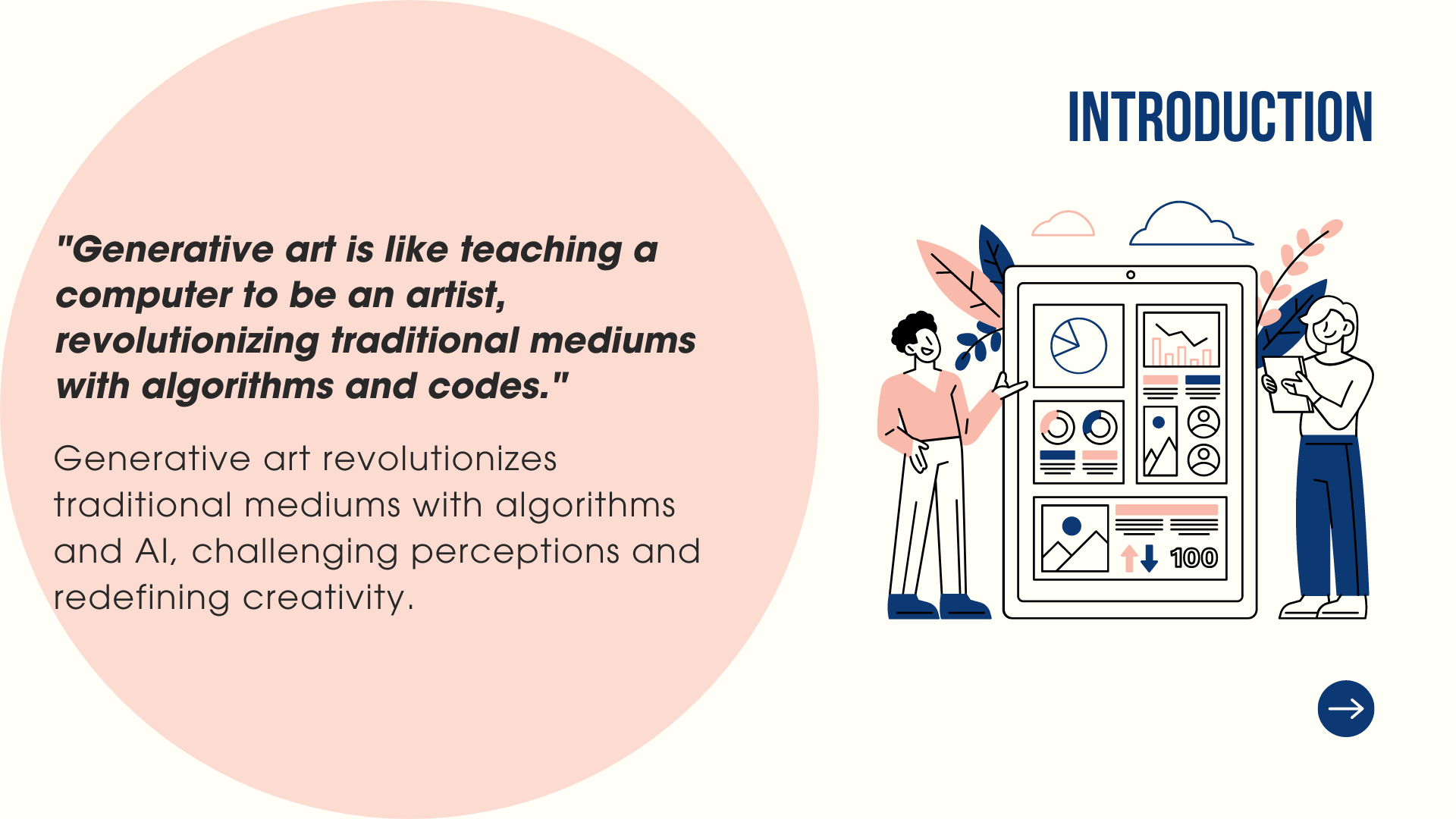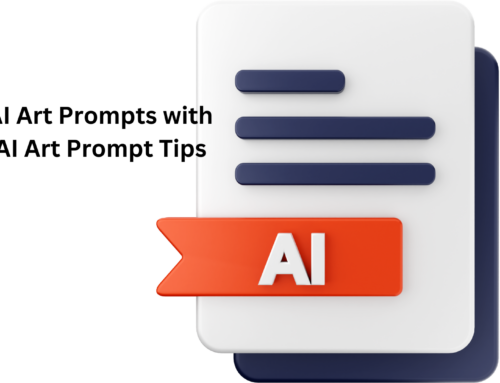Generative art is all about letting algorithms and computer programs do the creative heavy lifting. It’s like having a digital collaborator, but one that works with code instead of paintbrushes. And now, with the rise of generative art and new media forms, this collaboration is taking on a whole new level.

The Rise of Generative Art
In the art world these days, there’s a buzz about something called “Generative Art.” It’s this new media art where artists use digital tools to create their pieces of art. Instead of painting on a canvas or sculpting with clay, they’re using computers and software to make their digital art. You might wonder, what’s so special about it? Well, let me break it down for you. Generative art is all about using algorithms and codes to make art. It’s like teaching a computer to be an artist! Imagine that, right? So, these generative artists, they’re basically using artificial intelligence and geometric shapes to create their masterpieces. It’s like a whole new medium in the art world, shaking things up and making people see art in a different way.
How do AI art generators fit into the broader history and context of generative art?
Think of generative art as a big family tree, with AI art generators as the newest, tech-savvy cousins. Generative art has been around for a while, dating back to the 1960s when artists like Frieder Nake and Vera Molnár started using computers to create art. These early pioneers wrote code that produced visuals, often exploring randomness and algorithms to generate unique compositions.
James Heartquist, a Real Estate Expert, puts it like this, “AI art generators represent a significant evolution in the broader history and context of generative art. Generative art, which involves creating artwork through a set system, such as a set of natural language rules or a computer program, has been around since the mid-20th century. The first instances of computer-generated art date back to the 1950s and 1960s, when artists and computer scientists began exploring the potential of machines to create art. AI art generators, as we know them today, are part of this lineage, building upon decades of experimentation and development in the field. The introduction of Generative Adversarial Networks (GANs) and other AI techniques has revolutionized the way art is generated, allowing for the creation of complex and nuanced artworks that can mimic the styles of human artists or even create entirely new aesthetics.”
Parker Warren, The CEO of PWA Media, adds, “AI art generators have many commercial uses, like creating eye-catching ads, designing products, inspiring fashion, enhancing interior spaces, enriching entertainment, and personalizing experiences, showcasing their versatility and potential across industries,”
What new artistic mediums or formats could emerge from AI-powered generative systems?
One exciting possibility is the fusion of generative art and new media forms, like virtual reality (VR) or augmented reality (AR). Imagine stepping into a VR gallery where every artwork is dynamically generated in real-time based on your interactions. Or picture walking down the street with AR glasses that overlay AI-created street art onto the buildings around you. The possibilities are endless!
Another emerging medium is AI-generated music and soundscapes. Just as algorithms can create stunning visuals, they can also compose melodies and harmonies that evoke emotions and stir the soul. With AI-powered music generation, artists can explore new sonic landscapes and push the boundaries of what’s possible in sound.
According to Heartquist, “From AI-powered generative systems, new artistic mediums and formats are likely to emerge. These systems have the capability to produce high-quality artistic media across various domains, including visual arts, music, fiction, literature, video, and animation. As AI continues to advance, we may see the emergence of art forms that blend these domains, such as interactive installations that combine visual, auditory, and textual elements to create immersive experiences. AI could also lead to the development of dynamic artworks that evolve over time, adapting to environmental factors or audience interactions. The potential for AI to analyze and synthesize vast amounts of data could result in art that reflects complex patterns and relationships not easily discernible by humans.”
Parker Warren agrees, “Businesses can make money from AI-generated art by selling it, offering custom commissions, subscription services, partnerships, AI services, and educational programs. These not only generate revenue but also highlight their expertise in combining art and technology.”
Could AI art generators enable new forms of interactive, evolving, or responsive artworks?
Absolutely! One of the most exciting aspects of AI-generated art is its potential for interactivity and evolution. Imagine an artwork that responds to your gestures, changing shape and color as you move around it. Or consider a piece that evolves over time, adapting to new inputs and experiences to create a never-ending journey of discovery.
Heartquist explains, “Certainly, the potential for AI art generators to enable new forms of interactive, evolving, or responsive artworks is vast. These tools can create pieces that not only react to external stimuli but also have the ability to transform over time, offering a living, breathing form of art that can engage with audiences on a deeper level. Imagine walking into a gallery where the artwork changes color and form in response to the viewer’s movements or even their emotional state, detected through biometric sensors. Or consider a public installation that evolves throughout the day, reflecting the collective mood of the city as interpreted through social media sentiment analysis. The possibilities are endless, and as AI technology continues to advance, we can expect to see a proliferation of artworks that challenge our traditional notions of creativity and the role of the artist. These AI-driven creations could become platforms for exploring the complex interplay between technology, art, and human experience, opening up new avenues for artistic expression that are as yet unimagined. AI art generators, therefore, are not just tools for creating art; they are catalysts for a broader exploration of what art can be in the age of artificial intelligence.”
Parker Warren nods, “In industries such as gaming, entertainment, and digital media, AI art has the potential to make a big impact. It can simplify content creation, enhance visual effects, and personalize user experiences. This innovation promises to bring fresh creativity and efficiency to these fields, shaping the way we interact with digital content.”
The Creative Power of Code
When we talk about the creative power of code in the realm of generative art and new media forms, it’s like opening up a whole new world of possibilities. Let me break it down for you. So, imagine you’ve got these artists, right, who are also like tech wizards. They’re using new technologies, like coding and stuff, to create mind-blowing pieces of art. We’re talking about digital media here, where computer art meets contemporary art, and it’s like, wow! These artists are not just painting on a canvas; they’re coding up these mesmerizing visuals that can leave you staring for hours.
And then there’s this whole thing about NFT and blockchain. Now, I know it might sound a bit techy, but bear with me. So, NFTs, they’re like these digital certificates of authenticity for artwork, and blockchain, well, that’s the tech behind it, making sure everything’s legit and transparent. So, these new media artists, they’re not just creating art for the sake of it; they’re part of this whole new art movement, exploring the new frontier of interactive art in the digital world.
And you know what’s really cool? These artists are breaking free from the traditional forms of visual art. They’re experimenting with new digital tools, pushing the boundaries of what art may look like. It’s like art blocks are being shattered, and a whole new form of digital expression is emerging.
The Immersive Nature of New Media
So, let’s talk about how new media art is taking things from being just static to totally dynamic and immersive. Picture this: you’re standing in front of an art piece, but instead of it just sitting there, it’s moving, changing, evolving right before your eyes. That’s the magic of new media art, my friend. These artists are using all sorts of fancy tech stuff like AI and algorithmic data to create art projects that are never the same twice.
Now, if we look back at the history of generative art, we can see how far we’ve come. It used to be all about traditional art, you know, paint and canvas. But now, with computer graphics and all these on-chain generative art platforms, the game has totally changed. Artists like Vera Molnár paved the way, showing us that you don’t need a paintbrush to create art; you just need a generative system and a bit of imagination.
And here’s the really exciting part: with augmented reality, generative artwork is not just confined to galleries anymore. It’s spilling out into the streets, onto our phones, everywhere! Imagine walking down the street and seeing these digital masterpieces floating in the air around you. It’s like living in a whole new world where art is everywhere and anything is possible.
Unveiling the Process Behind Generative Art and New Media Forms
So, let’s dive into how generative art actually works. Imagine it’s like giving the computer a set of rules and letting it run wild with creativity! Artists began exploring this back in the day, especially with Harold Cohen, who was both an artist and a computer scientist. He really paved the way for using generative techniques in art.
So, here’s how it goes down:
- Artists to create: With generative art, artists don’t always have to manually create every single detail. They can set up the rules, and then let the computer do some of the heavy lifting.
- Art isn’t: And get this, generative art isn’t just about making pretty pictures. It’s about exploring the boundaries of what art can be.
- Computer program: It’s like the computer becomes an artist too! It follows the instructions given to it by the human artist, but it also adds its own twist.
- Background in fine art: Even if you’re not a computer whiz, you can still get into generative art. A background in fine art can actually be super helpful in understanding how to create meaningful pieces.
- New art: Generative art opens up a whole new world of possibilities. It’s not just about painting or sculpting anymore. It’s about creating art that moves, changes, and surprises.
So, whether it’s your first dip into generative art or you’re already knee-deep in algorithms and pixels, there’s always something new to explore in this exciting blend of technology and creativity.
New Roles and Responsibilities in Generative Art
Let’s talk about the new roles and responsibilities popping up in the world of generative art and new media forms. So, this form of art isn’t just about making pretty pictures; it’s about pushing boundaries and exploring new territories. Artists and collectors are coming together, buzzing around generative art like bees to honey. From early generative experiments with simple shapes and lines to full-blown algorithmic art, it’s like watching a whole new art scene unfold before our eyes.
Now, with generative art and new media forms, artists have this whole new set of responsibilities. They’re not just creating art; they’re shaping the future of art practice. And it’s not just about embracing new technologies like AI-generated art; it’s about using these tools responsibly. We’re seeing generative animations popping up in art exhibitions, shaking up the traditional art scene and making people sit up and take notice.
And let’s not forget about the collectors. They’re not just buying art to hang on their walls anymore; they’re investing in a whole new form of expression. They’re supporting artists who are pushing boundaries and challenging the status quo. It’s like a whole new ecosystem is forming around generative art, with artists and collectors working hand in hand to shape the future of art. Exciting times, my friend, exciting times.

Transforming Text into Artistic Creations
Let me introduce you to Airbrush AI, a super cool tool that’s changing the game for artists everywhere! It’s known as the first text-to-image generator out there, and it’s really shaking things up in the world of generative art. Here are some key features and benefits:
- Part of the creative: With Airbrush AI, it’s like you’re collaborating with a creative buddy. You give it the words, and it brings them to life in awesome visuals.
- Design studio: Think of it as having your own personal design studio, but without the mess! No need to stress about mastering complicated software or spending hours tweaking every detail. Airbrush AI does all the hard work for you.
- One of the first artists: Imagine being one of the first artists to try out a groundbreaking new tool. That’s the feeling you get with Airbrush AI. You’re right there on the cutting edge of creativity.
- Artists to get: Whether you’re a seasoned pro or just dipping your toes into the world of generative art, Airbrush AI is perfect for you. It’s super easy to use, so you can focus on bringing your ideas to life.
- Benefits: With Airbrush AI, the sky’s the limit! From creating jaw-dropping visuals for your latest project to exploring new ways to express yourself, this tool opens up a whole world of creative possibilities.
So, if you’re itching to take your generative art to new heights, why not give Airbrush AI a spin? Who knows what amazing creations you’ll come up with!
Challenges and Considerations in Generative Art
let’s wrap up our journey through the world of generative art and new media forms by talking about some of the challenges and things to think about.
One big thing is that while generative art and new media forms opens up all these new opportunities for artists, it also comes with its fair share of hurdles. For starters, not everyone has access to the fancy tools and technology needed to dive into this kind of art. Back when artists began to experiment with generative art, having access to a computer was a luxury! But hey, thanks to the rise of open-source software, things are a bit easier now. Still, there’s a learning curve to tackle, especially for artists and designers who might be more used to traditional mediums.
And then there’s the question of how generative art fits into the broader landscape of generative art and new media forms. With so many new media platforms popping up left and right, it can be tough for generative artists to find their place. But hey, challenges can also lead to innovation, right? Generative art is like the new kid in a class full of various media works, and it’s up to us to help it find its place.
So, as we get into our exploration of generative art and new media forms, let’s remember that while there are challenges ahead, there are also exciting possibilities waiting to be uncovered. Whether it’s creating a new piece using the latest tools or pushing the boundaries of what generative art can be, the future looks bright for this fascinating blend of creativity and technology.






Leave A Comment